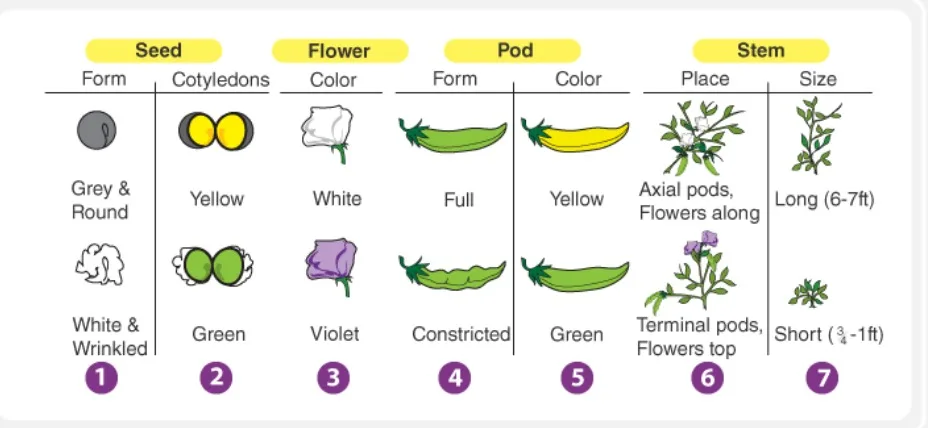
CBSE Class 12 Biology Notes Chapter 5
CBSE Class 12 Biology Notes Chapter 5: Use the thorough Chapter 5 Revision Notes on Principles of Inheritance and Variation to properly prepare for your CBSE Class 12 Biology final exams. To ensure a thorough knowledge of the material, these notes are made to cover every significant issue in the chapter.
Students can improve their knowledge and get decent grades on their board exams by consulting these notes.CBSE Class 12 Biology Notes Chapter 5 PDF
Our CBSE Class 12 Biology Notes Chapter 5 offers a summary of the chapter together with principles, examples, and illustrations for improved understanding. You can improve your knowledge and get a decent score on the board exams by consulting these notes.CBSE Class 12 Biology Notes Chapter 5 PDF
CBSE Class 12 Biology Notes Chapter 5 Principles of Inheritance and Variation
The process known as heredity occurs when genes are passed down through sexual reproduction from one generation to the next. Many inheritable traits and a variety of genes are passed down to the progeny, improving their ability to adapt to the rapidly changing environment. The chromosomes contain the genes that correspond to the qualities. Johann Gregor Mendel is known as "the father of genetics." Mendel's laws are the three basic laws of inheritance that he suggested.Mendel’s Experiment
 Gregor Mendel discovered the fundamental laws of inheritance through his research on pea plants. We are currently investigating the three laws of inheritance that he presented. He used 14 true-breeding pea plant kinds for his experiment and selected pea plants with seven opposing features of certain qualities.
Gregor Mendel discovered the fundamental laws of inheritance through his research on pea plants. We are currently investigating the three laws of inheritance that he presented. He used 14 true-breeding pea plant kinds for his experiment and selected pea plants with seven opposing features of certain qualities.
CBSE Class 12 Biology Previous Year Question Paper
Mendel’s Laws
3 laws were proposed by Mendel -Law of Dominance: This law states that the unit known as the factors control all of the characteristics or attributes. These variables, known as alleles, are discovered to exist in pairs. The term homozygous refers to alleles that occur in the same pair and can be either dominant or recessive; heterozygous refers to alleles that appear in different pairs and are always dominant.
"For instance, the allele for height predominates over the dwarfism allele." The law of segregation of genes is predicated on the observation that alleles do not blend and that, despite one of these traits not being present in the first generation, both characters are recovered as such in the second filial generation. A pair of alleles or factors are segregated so that the gamete receives only one of the two factors from each other. The Law of Independent Assortment postulates that, as features are passed down from one generation to the next, couples within the parental generation sort apart from one another. An illustration of it using a dihybrid cross is provided.Inheritance of One Gene
A monohybrid cross can be used to show how Mendel's law governs the inheritance of a single gene. By crossing tall and dwarf plants in this experiment, all tall hybrid plants in the F1 (First Filial or First) generation will be produced. After that, their progeny self-pollinates to produce the F2 generation, which consists of three tall plants and one dwarf plant. The ratio will therefore be 3:1.CBSE Class 12 Biology Chapter-Wise Weightage 2023-24
Incomplete Dominance
One kind of inheritance known as incomplete dominance occurs when one allele for a particular trait is not dominant over the other allele; in heterozygous organisms, neither allele is dominant over the other. This leads to a phenotype that is mixed. Partial dominance or mosaic dominance are other names for incomplete dominance. In this instance, completely new phenotypic traits are expressed. The marvel of Peru, Mirabilis jalapa, is also known as the "four o'clock plant." Because it inherits blossom colour, it is an excellent illustration of incomplete dominance. The graphic below illustrates how red flowers, which are dominant, cross with white flowers, which are recessive. The resulting F1 generation of flowers had pink flowers, which are intermediate in colour.Chromosomal Theory of Inheritance
Walter Sutton presented the chromosomal theory of heredity in 1902. The linear shape of chromosomes with genes located at certain locations, referred to as loci, is also explained by this hypothesis. Boveri also looked into this theory independently. Thus, the Boveri-Sutton chromosome theory is another name for this theory. As per this theory: (i) On chromosomes, genes are located at particular positions. (ii) The homologous chromosomes split apart during meiosis. (iii) The number of chromosomes becomes diploid during fertilisation. (iv) Individual chromosomes separate and assemble separately.Sex Determination
The procedure known as "sex determination" allows the child's gender to be disclosed. Children's sex is determined by their sex chromosomes. When it comes to humans, males have one X and one Y type of chromosome, whereas females have XX types. As a result, each female gamete that forms from an egg will have an identical X chromosome, whereas male sperm, or male gametes, differ in that they have one X chromosome and one Y chromosome. Therefore, which sperm (X or Y) unites with the egg is a question of chance. As a result, it is argued that whereas men and females have different types of chromosomes, homogametic females have the same type. In insects, the sex determination mechanism belongs to the XO type. In this case, the sperm may have one or more X chromosomes, while the eggs have all of the X chromosomes. Accordingly, it is argued that although females are heterogametic (having various types of chromosomes), males are homogametic (having the same type of chromosomes).Mutation
Mutations are sudden alterations in the DNA sequence. Both an individual's genotype and phenotype may be impacted by genetic alterations that are heritable and will be passed down to the next generations. Frameshift mutations, insertions, deletions, duplications, substitutions, etc. are among the several kinds of mutations. Mutations may have negative effects or none at all. Frameshift mutations are variations in the reading frame caused by additions or deletions of DNA nucleotides. (ii) Insertions are the addition of new nucleotides to DNA. (iii) Deletions are the removal of DNA nucleotides. (iv) A DNA fragment is referred to as duplicated if it is copied more than once.Related Links -
| CBSE Class 12 Biology Notes Chapter 2 |
| CBSE Class 12 Biology Notes Chapter 5 |
| CBSE Class 12 Biology Notes Chapter 7 |
| CBSE Class 12 Biology Notes Chapter 9 |
| CBSE Class 12 Biology Notes Chapter 3 |
Genetic Disorders
Pedigree Analysis
A pedigree chart shows the appearance and occurrence of specific phenotypes of a given gene and organism. As a result, a chart that is simple to read presents the family information.Mendelian Disorders
Mendelian illnesses and chromosomal disorders are the two types of genetic disorders. A single gene's mutation or change is the source of Mendelian diseases. Haemophilia, Sickle-cell anaemia, Cystic fibrosis, colour blindness, Thalassemia, phenylketonuria, and other conditions are among the most prevalent instances of these illnesses. It is discovered that Mendelian disorders can be recessive or dominant. Additionally, the feature has been connected to sex chromosomes that are associated with sex-linked disorders, such include haemophilia and colour blindness.Chromosomal Disorders
The addition, deletion, or aberrant organisation of one or more chromosomes results in chromosomal abnormalities. The condition known as aneuploidy is caused by incorrect chromatid segregation during the cell division cycle, which determines whether chromosomes are added or subtracted. For instance, an additional copy of chromosome 21 is present in the findings of Down's syndrome. In a similar vein, female humans with Turner's disease lose one X chromosome. The other circumstance is polyploidy, which is primarily observed in plants and results in an increase in an organism's total number of chromosomes when the process of cytokinesis is absent following the telophase stage of cell division.CBSE Class 12 Biology Notes Chapter 5 FAQs
What is the principle of inheritance and variation short note?
What is the conclusion of the principles of inheritance and variation?
What are the principle laws of inheritance Class 12?










